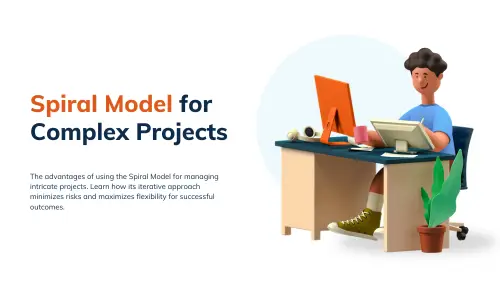The Benefits of the Spiral Model for Complex Projects

Grok: Top 10 Use Cases in Software Development
April 2, 2025
What is Green Technology and How is It Shaping Environmental Progress
April 4, 2025When it comes to managing complex software development or intricate project lifecycles, choosing the right methodology can make or break success. One approach that stands out for its adaptability and risk-focused design is the Spiral Model. Introduced by Barry Boehm in 1986, this iterative framework combines the best of traditional waterfall processes with modern prototyping techniques. It’s particularly suited for projects where requirements evolve, risks are high, and flexibility is non-negotiable. In this blog, we’ll dive deep into the benefits of the Spiral Model, exploring why it’s a go-to choice for tackling complexity in today’s fast-paced industries.
What Is the Spiral Model?
Before we unpack its advantages, let’s clarify what the Spiral Model entails. Unlike linear methodologies, this approach operates in cycles or “spirals.” Each spiral consists of four key phases: planning, risk analysis, engineering, and evaluation. These phases repeat iteratively, allowing teams to refine their work, address uncertainties, and build incrementally. This cyclical nature ensures that the project evolves with continuous feedback, making it ideal for large-scale or ambiguous endeavors.
Why Choose the Spiral Model for Complex Projects?
Complex projects—think aerospace systems, cutting-edge software, or innovative product development—often come with shifting requirements and unpredictable challenges. The Spiral Model shines in these scenarios because it prioritizes adaptability and risk management over rigid timelines. Let’s explore its standout benefits and why it’s a game-changer for intricate initiatives.
Enhanced Risk Management
One of the biggest hurdles in complex projects is unforeseen risks—be it technical glitches, budget overruns, or scope creep. The Spiral Model tackles this head-on by embedding risk analysis into every cycle. Before moving forward, teams assess potential pitfalls and devise mitigation strategies. This proactive stance minimizes surprises down the line, ensuring that issues are caught early when they’re easier to fix. For industries like healthcare or defense, where errors can have serious consequences, this focus on risk is invaluable.
Flexibility to Adapt to Change
In today’s dynamic business landscape, project requirements rarely stay static. Clients might request new features, or market trends could shift mid-development. Traditional models like Waterfall struggle with such fluidity, but the Spiral Model thrives. Its iterative structure allows teams to revisit and adjust plans at the end of each cycle. This adaptability ensures the final product aligns with current needs, not outdated specifications, making it a perfect fit for innovative or experimental projects.
Early Prototyping and Feedback
Another key strength is the emphasis on prototyping. In each spiral, teams create tangible deliverables—whether a mockup, a partial system, or a working module. Stakeholders can test these prototypes and provide feedback early in the process. This hands-on evaluation reduces misunderstandings and ensures the project stays on track. For complex projects with multiple stakeholders, such as government contracts or enterprise software, this iterative feedback loop fosters collaboration and clarity.
How the Spiral Model Boosts Efficiency
While flexibility and risk management are critical, efficiency is equally important in complex projects. The Spiral Model delivers here too, offering a structured yet practical approach to resource use and timelines.
Incremental Development
Rather than waiting until the end to deliver a finished product, the Spiral Model builds in increments. Each cycle produces a usable component, allowing teams to demonstrate progress and refine their work as they go. This incremental approach not only keeps momentum high but also enables early deployment of critical features. For example, a software firm might release a basic version to users while continuing to enhance it in subsequent spirals.
Cost Control Through Iteration
Budget overruns are a common headache in large projects, but the Spiral Model helps keep costs in check. By breaking the process into manageable cycles, teams can monitor spending and adjust plans accordingly. If a particular phase reveals a feature isn’t feasible, it can be scrapped or reworked before too many resources are sunk into it. This iterative cost evaluation is a lifeline for projects with tight financial constraints.
Real-World Applications of the Spiral Model
To truly appreciate its value, let’s look at how the Spiral Model performs in practice. It’s widely used in industries where complexity and stakes are high. For instance, NASA has leveraged this methodology for space mission software, where precision and adaptability are non-negotiable. Similarly, tech giants developing AI systems or next-gen applications often turn to this framework to balance innovation with reliability. These examples highlight its versatility across domains.
Comparing the Spiral Model to Other Methodologies
To understand its unique edge, it’s worth comparing the Spiral Model to alternatives like Waterfall and Agile. Waterfall follows a linear path, making it less suited for projects with evolving needs. Agile, while flexible, focuses on rapid sprints and may lack the structured risk analysis that complex projects demand. The Spiral Model bridges this gap, blending iteration with a methodical focus on risks and planning—ideal for scenarios where neither speed nor rigidity alone will suffice.
Stakeholder Confidence and Transparency
Complex projects often involve multiple parties—clients, developers, investors—all of whom need assurance that their interests are protected. The Spiral Model fosters trust by keeping stakeholders in the loop. Regular prototypes, risk reports, and evaluations provide transparency into progress and challenges. This open communication builds confidence, ensuring everyone stays aligned even as the project evolves.
Challenges to Consider
No methodology is perfect, and the Spiral Model has its trade-offs. Its iterative nature can lead to longer timelines compared to linear approaches, and the focus on risk analysis requires skilled personnel. For smaller projects with clear requirements, it might even feel overly elaborate. However, for complex undertakings where uncertainty reigns, these challenges are a small price to pay for the stability and adaptability it offers.
Tips for Implementing the Spiral Model Successfully
Ready to harness its benefits? Here are some practical tips to make it work:
- Invest in Risk Expertise: Ensure your team includes members skilled in identifying and mitigating risks.
- Engage Stakeholders Early: Get their input from the first spiral to align expectations.
- Set Clear Milestones: Define what each cycle should achieve to maintain focus.
- Leverage Tools: Use project management software to track progress across spirals.
By following these steps, you can maximize the Spiral Model’s potential and steer your complex project toward success.
Why the Spiral Model Is Here to Stay
In an era of rapid technological advancement and ever-shifting demands, methodologies like the Spiral Model are more relevant than ever. Its ability to handle ambiguity, prioritize risks, and deliver incrementally makes it a cornerstone for complex project management. Whether you’re building groundbreaking software, designing intricate systems, or navigating uncharted territory, this approach offers a roadmap to success that’s both structured and flexible.
Conclusion
The Spiral Model isn’t just a methodology—it’s a mindset. By embracing iteration, risk awareness, and stakeholder collaboration, it transforms the chaos of complex projects into a manageable, step-by-step journey. From early prototyping to cost control, its benefits are clear: it empowers teams to innovate confidently while keeping risks at bay. If you’re facing a project with high stakes and higher uncertainty, exploring the Spiral Model could be the key to turning challenges into opportunities. What do you think—could this approach work for your next big endeavor?


